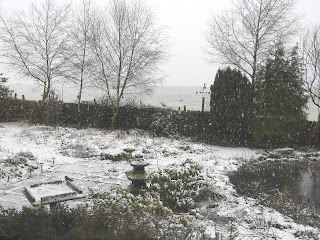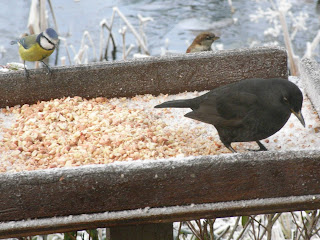Nature's Minstrels
 Ever the optimist, not even the darkest days of Winter, which brings its mixed bag of rain, hail, sleet and snow, can ever dampen my spirits as long as I can be part of the silence and observe the wonderful array of birdlife which visits the Barleycorn garden.
Ever the optimist, not even the darkest days of Winter, which brings its mixed bag of rain, hail, sleet and snow, can ever dampen my spirits as long as I can be part of the silence and observe the wonderful array of birdlife which visits the Barleycorn garden. A garden without birds is like a garden without flowers. There is nothing better than to be serenaded by beautiful birdsong at any time of the year, though it is in Winter when I am able to identify the birds most clearly.
A garden without birds is like a garden without flowers. There is nothing better than to be serenaded by beautiful birdsong at any time of the year, though it is in Winter when I am able to identify the birds most clearly. That is not to say that there is nowhere the birds can find shelter at Barleycorn in Winter, for we have ivy covering both eaves of the barn in which sparrows, wrens, blackbirds and starlings like to roost.
That is not to say that there is nowhere the birds can find shelter at Barleycorn in Winter, for we have ivy covering both eaves of the barn in which sparrows, wrens, blackbirds and starlings like to roost. Our beech hedge affords some temporary respite also, as it retains its Autumnal coat right through till Spring.
Our beech hedge affords some temporary respite also, as it retains its Autumnal coat right through till Spring. Of course, there is the barn itself to roost in, as we have removed the odd pane of glass; and a large gap above the doors also allows the birds freedom of access to come and go as they please.
Of course, there is the barn itself to roost in, as we have removed the odd pane of glass; and a large gap above the doors also allows the birds freedom of access to come and go as they please. Best of all, however, are the large number of mature evergreens we have planted over the years, for beneath them the earth is always dry enough to shelter ground-feeders such as dunnocks and blackbirds; and their thick-set branches offer copious perches, as well as the added bonus of a handful of empty nests left over from the previous Summer.
Best of all, however, are the large number of mature evergreens we have planted over the years, for beneath them the earth is always dry enough to shelter ground-feeders such as dunnocks and blackbirds; and their thick-set branches offer copious perches, as well as the added bonus of a handful of empty nests left over from the previous Summer. A strange anomaly is how the birds and the cats manage to live in harmony in the garden without the cats depleting the numbers which come to bathe, feed and make nests in the garden.
A strange anomaly is how the birds and the cats manage to live in harmony in the garden without the cats depleting the numbers which come to bathe, feed and make nests in the garden. Part of the answer to this puzzle, of course, is that the birds use their wings to escape from prowling cats. As an added precaution, we make sure the feeding stations are well out of reach of any would-be predators, for, each time the birds visit, they also search the nooks and crannies for their natural food, which is a recompense to us as it ensures our flowers and plants are safe from the ravenous hordes of aphids and insects.
Part of the answer to this puzzle, of course, is that the birds use their wings to escape from prowling cats. As an added precaution, we make sure the feeding stations are well out of reach of any would-be predators, for, each time the birds visit, they also search the nooks and crannies for their natural food, which is a recompense to us as it ensures our flowers and plants are safe from the ravenous hordes of aphids and insects. In Winter there is less of a problem as we have the containers hanging high enough in the bare trees, thus ensuring the cats have no camouflage and can therefore do no damage.
In Winter there is less of a problem as we have the containers hanging high enough in the bare trees, thus ensuring the cats have no camouflage and can therefore do no damage. In Summer when the trees are covered in foliage, we move the feeders higher still and make sure they are away from obvious hiding places such as walls or perches from which the cats could gain access.
In Summer when the trees are covered in foliage, we move the feeders higher still and make sure they are away from obvious hiding places such as walls or perches from which the cats could gain access. As cats like to have regular feeding times and sleep for a good part of the day, it is advisable to ensure the cats have been well-fed before letting them out, especially in Summer when the birds are feeding broods of chicks.
As cats like to have regular feeding times and sleep for a good part of the day, it is advisable to ensure the cats have been well-fed before letting them out, especially in Summer when the birds are feeding broods of chicks. To further assist the success of the birds we also wait until the cats have come back indoors, usually for a catnap, before the feeders and the bird-table have been replenished.
To further assist the success of the birds we also wait until the cats have come back indoors, usually for a catnap, before the feeders and the bird-table have been replenished. The positioning of the feeders is of paramount importance both to the birds for reasons of safety; and to us so that we may have visible access for a spot of bird-watching.
The positioning of the feeders is of paramount importance both to the birds for reasons of safety; and to us so that we may have visible access for a spot of bird-watching. From my vantage point through the patio windows overlooking the garden, I am able to sit in comfort and photograph the birds which come to satisfy their hunger from the banquet table, attracting them like a magnet, groaning with copious amounts of seed, fat-balls and scraps with which my husband tempts our feathered friends.
From my vantage point through the patio windows overlooking the garden, I am able to sit in comfort and photograph the birds which come to satisfy their hunger from the banquet table, attracting them like a magnet, groaning with copious amounts of seed, fat-balls and scraps with which my husband tempts our feathered friends. The little edges my husband has added around the tray help to prevent the food spilling over onto the ground and also act as an added perch for the smaller birds which have to compete in the pecking order for the food.
The little edges my husband has added around the tray help to prevent the food spilling over onto the ground and also act as an added perch for the smaller birds which have to compete in the pecking order for the food. The dictionary defines ‘symbiosis’ as ‘a living together of two different organisms to the mutual benefit of both.’ Since my dream was to create a garden for wildlife, I would say that was a fair description of our relationship with the birds.
The dictionary defines ‘symbiosis’ as ‘a living together of two different organisms to the mutual benefit of both.’ Since my dream was to create a garden for wildlife, I would say that was a fair description of our relationship with the birds. I would further add that we are the main beneficiaries, for in return for their food, we are blessed with the beautiful dawn chorus each Spring; exquisite birdsong throughout the Summer and Autumn to sweeten the rainiest of days and enhance the sunniest, not to mention having Nature’s most efficient and natural deterrents to counteract the effects of the swarming populations of insects.
I would further add that we are the main beneficiaries, for in return for their food, we are blessed with the beautiful dawn chorus each Spring; exquisite birdsong throughout the Summer and Autumn to sweeten the rainiest of days and enhance the sunniest, not to mention having Nature’s most efficient and natural deterrents to counteract the effects of the swarming populations of insects. But, superceding all of these, is the sheer delight in renewing our acquaintance each season with the wonderful variety of birdlife proudly wearing their technicoloured dream-coats.
But, superceding all of these, is the sheer delight in renewing our acquaintance each season with the wonderful variety of birdlife proudly wearing their technicoloured dream-coats. What better way to while away the time when the weather dons its Winter overcoat, than to fetch one’s camera and record the passing show?
What better way to while away the time when the weather dons its Winter overcoat, than to fetch one’s camera and record the passing show? Each little flower that opens,
Each little flower that opens,Each little bird that sings,
He made their glowing colours,
He made their tiny wings.
Cecil Frances Alexander
 Click on the photos to enlarge them and find the names of the birds.
Click on the photos to enlarge them and find the names of the birds.Click here to see our unexpected visitor.


















